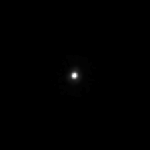(307261) 2002 MS4
(307261) 2002 MS4 is a large classical Kuiper belt object. It is a possible dwarf planet in the Kuiper belt. It was discovered in 2002 by Chad Trujillo and Michael Brown.[1]

The Spitzer Space Telescope estimated it to have a diameter of 726±123 km, while the Herschel Space Telescope estimated it to be 934±47 km.[2]
2002 MS4 does not have any known moons orbiting it, thus an accurate mass estimate cannot be made. Based on its size, Brown lists it as nearly certain to be a dwarf planet, however, its low albedo may imply the opposite: dark, mid-sized bodies such as this, less than about 1000 km in diameter and with albedos less than about 0.2, have likely never collapsed into solid bodies, much less differentiated or relaxed into hydrostatic equilibrium, and thus are unlikely to be dwarf planets.
As of 2019, the rotation period of 2002 MS4 is unknown. Observations in 2005 and 2011 showed possible periods of either 7.33 hours or its alias 10.44 hours (single-peaked), or twice those values for the double-peaked solution, with a small light curve amplitude of 0.05±0.01 mag. Light curve observations of 2002 MS4 are difficult because of the dense field of background stars it is crossing. Observations made in June and July 2011 took advantage of 2002 MS4 moving in front of a dark nebula.
References
change- ↑ "JPL Small-Body Database Browser". ssd.jpl.nasa.gov. Retrieved 2020-12-05.
- ↑ Barucci, M. Antonietta (2008). The Solar System Beyond Neptune. University of Arizona Press. ISBN 978-0-8165-2755-7.